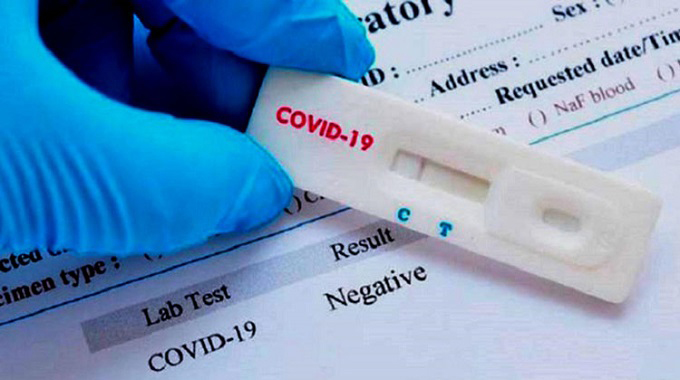EDITORIAL COMMENT : Let’s push harder to contain the pandemic

The intensification of the lockdown imposed a week ago seems to be stabilising the higher Covid-19 infection rates seen in Zimbabwe, which while still a cause for concern are at least not getting significantly worse with most people observing the general and special rules and following the advice.
But an average of over 1 000 new cases a day is not something to get complacent about.
The intensified lockdown rules do work, as the figures show in Mashonaland West where three districts containing most of the hotspots were put under the intensified lockdown earlier.
While the province still records more than a third of the confirmed new cases each day, although some of that might arise from more active contact tracing, the number of daily new recoveries usually exceeds the number of new cases.
This suggests that the peak has been reached in those hotspots and we are facing the long slow grind of waiting for sick people to get better and making sure that those they might come into contact with are taking maximum precautions.
The province is far from being out of the woods, but at least it is coping. The rest of us are still seeing more infections than recoveries, so obviously have to press harder on compliance of the basic precautions.
The emergence of hotspots outside major cities was always a possibility, and the fact that small towns and villages have recorded infections means that we cannot lower our guard anywhere.
But the fact that infection rates in those hotspots are starting to fall suggests that the people there are following the advice and taking Covid-19 seriously.
One problem that did emerge is that district and small town hospitals do not have much in the way of intensive care units, just the odd bed to deal with accidents or normal emergencies.
But the referral system is working and those who need special care are being transferred to the larger hospitals where well-equipped Covid-19 wards are available.
Only about four percent of patients actually need to be in hospital, and only a small fraction of those need intensive care, so as long as we can stabilise infection rates, the medical system can cope and the public health authorities have been making preparations to ensure there are enough beds, oxygen supplies and the other back-up needed.
The critical factor is to make sure that daily infection rates are not growing to higher levels, hence the intensification of the lockdown and the pressure for everyone to wear their masks and observe social distancing.
There are concerns about new variants, and regrettably, as could be expected, there is nonsense circulating on social media platforms quoting unknown “experts”.
The main danger from the new Alpha and Delta variants is not they are more lethal, since they appear to be about the same as the “ordinary” initial Covid-19 virus, but that evidence shows they are more infectious, that is they are a lot easier to catch and lot easier for someone infected to pass on the virus.
This is what has caused the surge in infections and thus in hospital cases in those countries that have been more severely affected. It is also the reason why the standard Covid-19 precautions have to be rigidly followed and why contact tracing has to be more active.
A more infectious variant will have a longer chain of infection and be harder to block early.
One good point is that the vaccines work with about the same degree of effectiveness as they do against the initial variant, so there is no need to develop new vaccines and start from the beginning.
The inactive vaccines that Zimbabwe uses are, in any case, more likely to cope with any mutated viruses that some of the specially targeted live vaccines.
But vaccinated people should not assume they can run around maskless and go to parties every night. No vaccine is 100 percent effective so it is still possible to be infected. A vaccinated person is far less likely to catch the virus, and more likely to get better quickly if they do, but the risks are still there.
This is why every country is gunning for “herd immunity”, having a high enough percentage of vaccinated people that infection chains will be very short and eventually there will be no chains.
But Zimbabwe is only about 5,7 percent of the way to the minimum level of herd immunity, that is having enough people with both doses of vaccine.
While there has been a general tightening up of precautions, the fact that the police had to arrest 10 000 people in the first three days of the intensified lockdown and dish out the deposit fines and give the warnings, suggests there is still a decent minority who either do not care or who feel socialising and wandering around among other people without a mask is worth the extra risk.
Those of us in essential services who have to go home after curfew noted that there was a dramatic decrease in late night traffic last week when the new curfew came into force, but on Friday there was a sudden surge as fairly obviously some decided they could not do without meeting friends on a traditional social night. It died down again by Sunday.
While we hope police are applying the curfew with discretion, since a significant group of people, especially those who need two buses to get home from work, might need a bit longer to get home considering the fact that Zupco has yet to reach its planned fleet, the police are quite correct in assuming anyone driving or wandering around late at night well after the curfew hour who is not in an essential service or dealing with a medical emergency is deliberately breaching the curfew for social reasons.
The main reason for the curfew is to enforce the ban on social activity. While in a business environment compliance is fairly good, a group of people enjoying food and drink together are obviously not masked and are probably not sitting far apart.
The other factor is the need to speed up vaccination. Rates have been rising slowly since the last shipment of 500 000 doses arrived, but not really fast enough.
There appears to be still more demand than teams can cope with, even if some in the higher priority groups have yet to stand in line, and it appears we need to work out how to get more teams operating and contact the groups we really want to vaccinate.
A huge new shipment of two million doses is now about to arrive and we hope the authorities are prepared to get more teams out with more doses and tell people who are at highest risk where they should go.
By moving swiftly early Zimbabwe is probably going to beat the third wave without too many deaths. But that still requires the perpetual vigilance we must all exercise. The life you save could be your own.










Comments